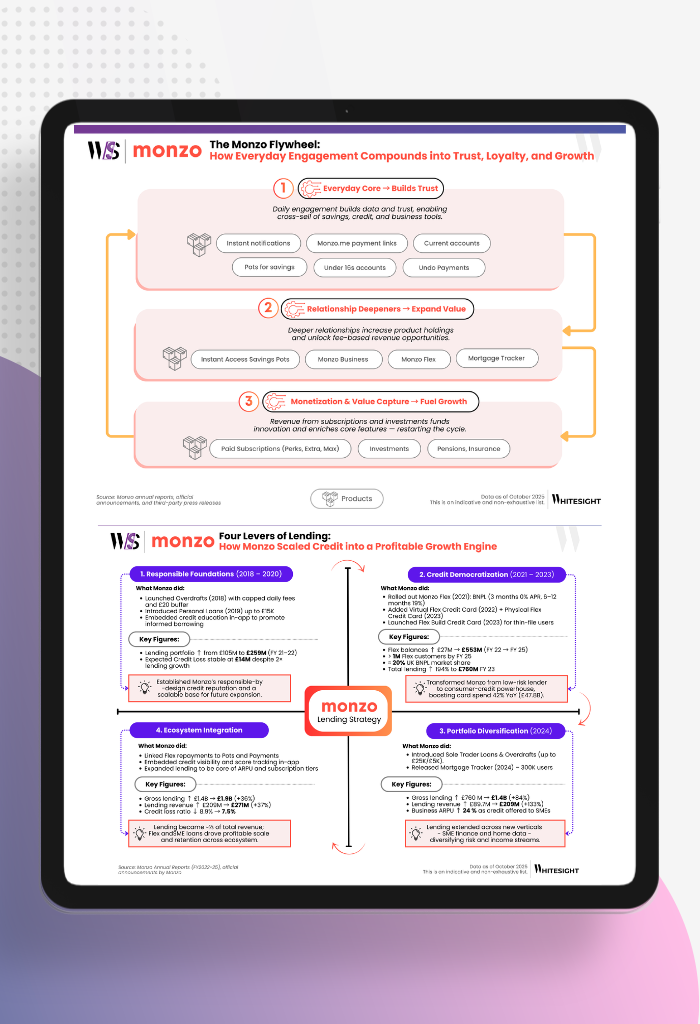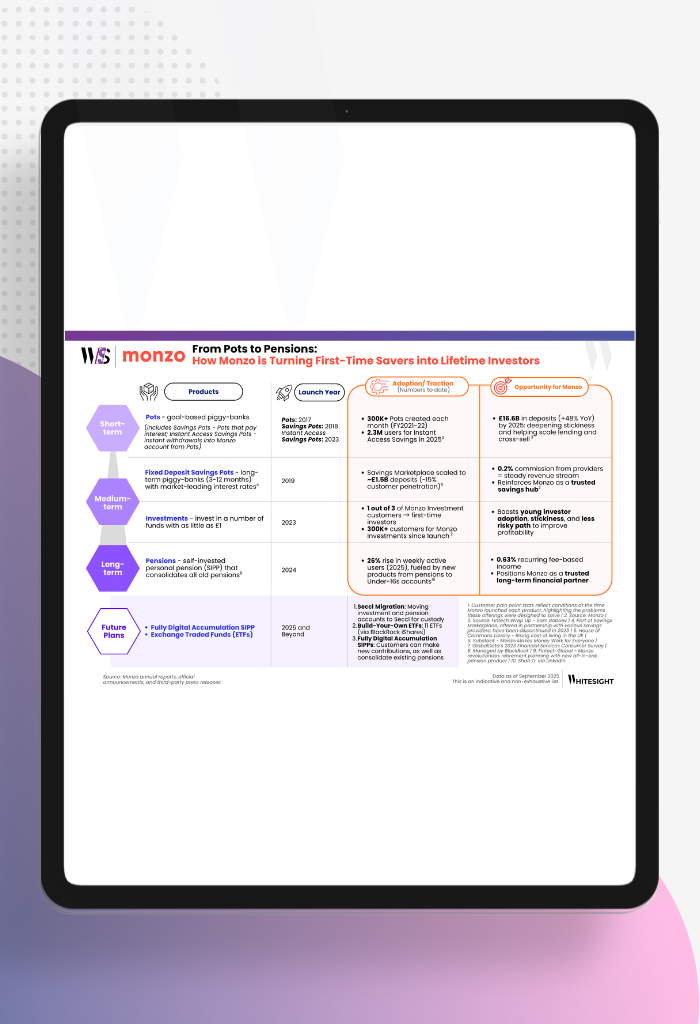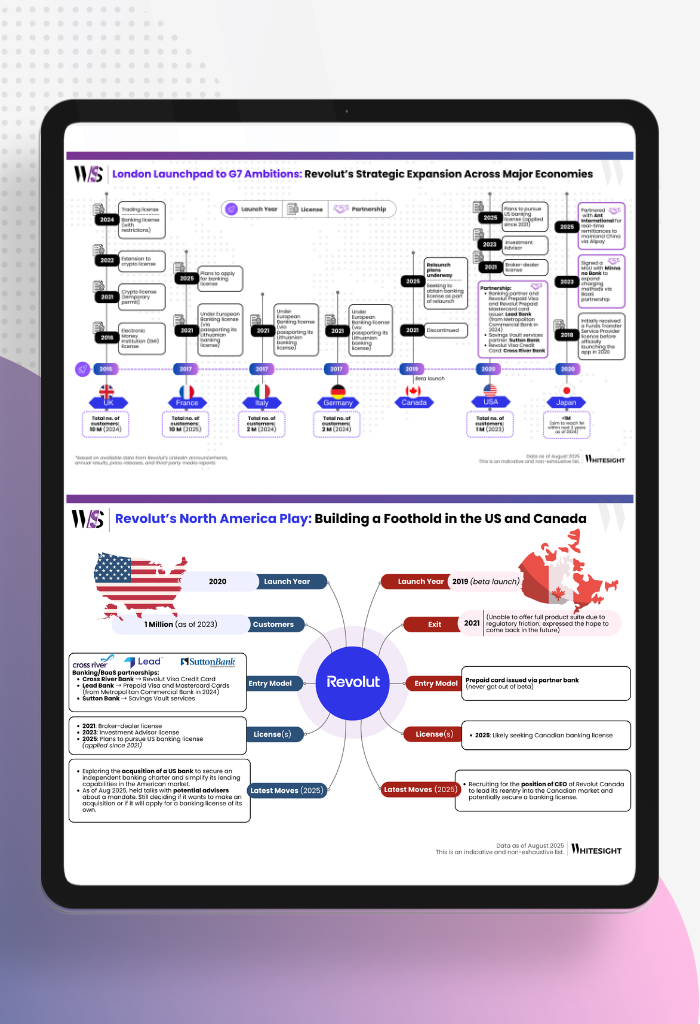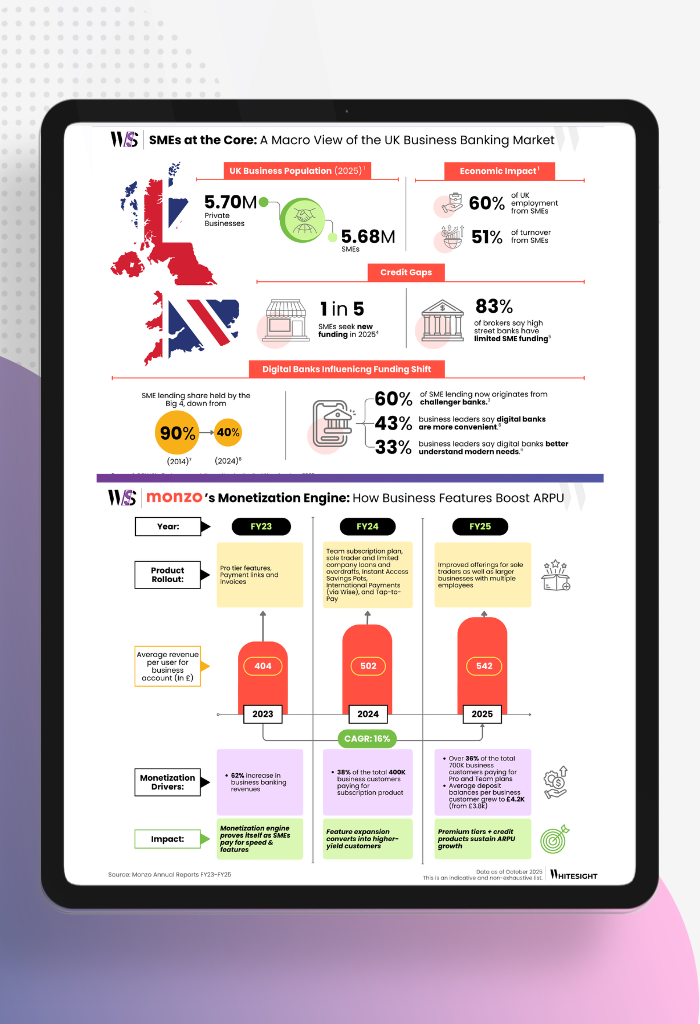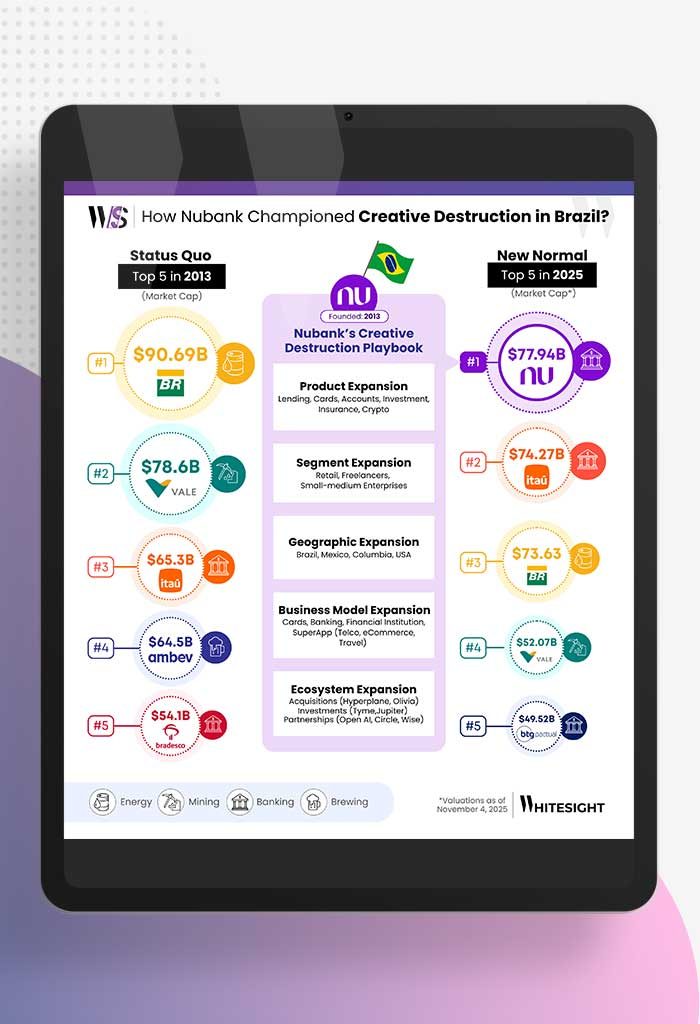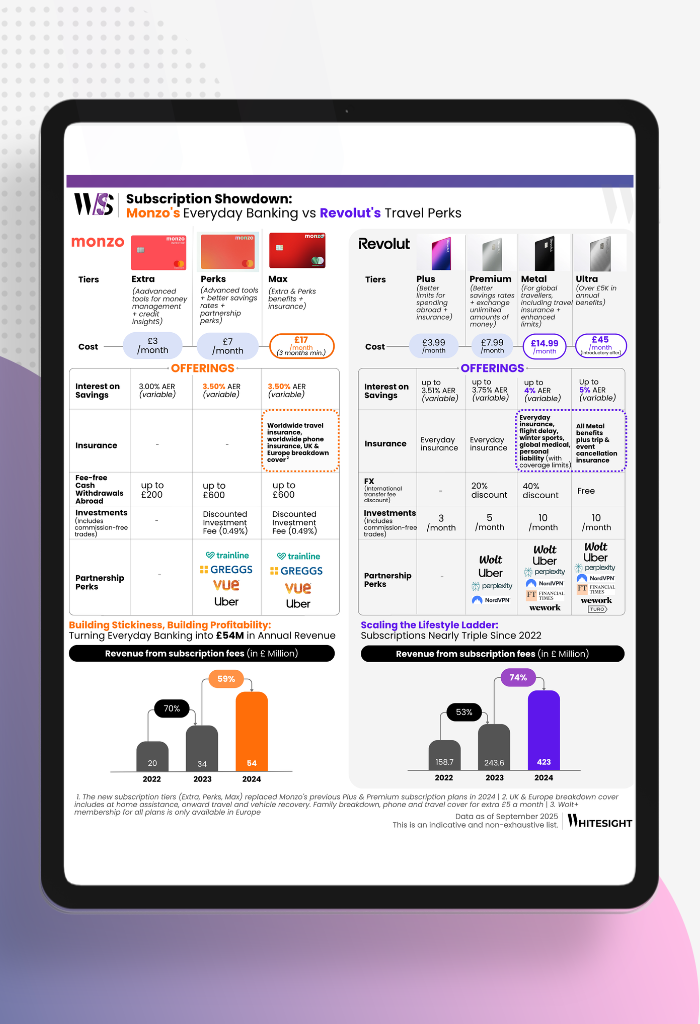Nubank’s Secured Lending Portfolio
- Sanjeev Kumar
- 6 mins read
- Digital Finance, Partnerships
Table of Contents
The Landscape: Why Lending in Brazil Has Always Been Broken
Before Nubank entered the scene, retail lending in Brazil was a game rigged against the average individual. Interest rates on personal loans often topped 100% per year.
Why? A toxic cocktail of structural issues:
- Sky-high benchmark rates: Brazil’s base interest rate (SELIC) historically hovered above 10% for much of the past two decades. For example, in 2015, SELIC peaked at 14.25% (Source: Banco Central do Brasil).
- Lack of competition: Five banks controlled over 80% of total assets in the Brazilian banking system by 2019 (Source: IMF Financial Sector Assessment Program 2018).
- High risk premium: Brazil’s average spread between borrowing and lending rates was over 30 percentage points in the 2010s (Source: World Bank Global Financial Development Database).
- Operational inefficiencies: Traditional banks incurred high operating costs, with average cost-to-income ratios around 50%-60% (Source: TheGlobalEconomy).
- Low financial inclusion: As recently as 2017, about 45 million Brazilians were “unbanked” or underbanked (Source: World Bank Global Findex Database).
The result? Credit access was either nonexistent or prohibitively expensive for a huge portion of Brazil’s population.
Enter Nubank: Rewriting the Playbook with Secured Lending
Nubank didn’t just lower interest rates. It reengineered the entire risk model to reduce rates and unlock accessibility to underserved customer segments. This enabled it to acquire more customers and serve them through a sustainable business model. Instead of pushing high-interest personal loans to risky borrowers, Nubank built a portfolio of credit products where the repayment is automatic, predictable, and backed by some form of collateral. These are loans that are designed to be hard to default on.
- One example is the FGTS-backed loan. FGTS, or Fundo de Garantia do Tempo de Serviço, is Brazil’s mandatory severance savings fund. Employers pay into it monthly on behalf of workers, and Nubank allows customers to take out a loan against their future FGTS
- Another smart product is the investment-backed loan. If a customer has money in a Nubank savings pot, time deposits or in certain fixed-income investments like Tesouro Direto (Brazil’s treasury bond platform), they can use those assets as collateral to get a loan, without liquidating them.
- Then there’s the heart of the playbook: payroll-deducted loans, known in Brazil as empréstimos consignados. These are automatically repaid from the borrower’s salary or pension before the money even hits their bank account. It’s this mechanism that allows Nubank to offer credit with very low default risk—and very competitive rates.
Nubank's Deep Dive Report 📔
Nubank’s building a case as the most dominant fintech on the planet. With 114M+ users, $2B+ in net income, and metrics that legacy and challenger banks would kill for, Nu is proof that fintechs can scale and stay profitable. In a region where high cost-to-serve and low credit access are the norm, Nubank built a lean, digital-first platform that’s low-cost, hyper-scalable, and sticky.
WhiteSight’s latest deep dive distills the plays, pivots, and product bets that fuel Nubank’s rise across LATAM.
WhiteSight’s latest deep dive distills the plays, pivots, and product bets that fuel Nubank’s rise across LATAM.
Report
Who’s Eligible? Pretty Much Everyone Now
Nubank has aggressively expanded access. The first wave focused on federal civil servants through Brazil’s SIAPE system, a centralised payroll system for public employees. Then came retirees and pensioners who receive their monthly benefits through INSS, Brazil’s national social security institute. These customers have ultra-predictable cash flows, making them ideal candidates for automated repayment loans.
By mid-2024, Nubank had signed agreements with the Brazilian Armed Forces, covering active and retired personnel across the Army, Navy, and Air Force. Soon after, it locked in deals with major municipalities like São Paulo, Rio de Janeiro, and Belo Horizonte, as well as state governments including Paraná, Minas Gerais, and Rio de Janeiro.
And then came the biggest step yet in April 2025, Nubank rolled out payroll loans to formal private sector employees. These are workers registered under Brazil’s CLT regime, and the loans are offered through integration with CTPS Digital, the country’s national digital work card app. Brazil has millions of CLT-registered workers in the private sector—many of whom historically lacked access to safe, low-cost loans.
Unlock the deep dives into the winning strategies of Stripe, Apple, Starling Bank, and more with a WhiteSight Radar Membership.
Join 4,000+ fintech buffs already subscribed and get unparalleled access to expert reports, industry trend breakdowns, and exclusive insights on everything from Embedded Finance to Digital Banking, Open Finance and beyond—all at a fraction of the cost of market alternatives.
Supercharge your Fintech IQ with WhiteSight Radar, putting expert fintech intel at your fingertips! You’ll be joining a growing global community of fintech professionals. 🧭
Fintech's future on your radar
Actionable insights on fintech, delivered regularly. Join Radar for exclusive fintech content and member benefits.
How the Repayment System Works—And Why It’s Safer
The repayment mechanism is what makes this model so powerful. Whether you’re a federal employee or a city hall janitor, your loan repayment gets deducted at the source. For pensioners, it’s pulled from their INSS benefits. For the military, it comes from the defence payroll. For private sector workers, it flows through employer payroll integrations enabled via CTPS Digital.
In the case of private sector borrowers, Nubank goes a step further. If the borrower is dismissed, the bank can recover its loan using two elements of the FGTS system: 10% of the worker’s FGTS balance and 100% of the termination fine (a 40% penalty employers pay upon dismissal). It’s a clever, built-in protection against job loss risk and one that doesn’t depend on the borrower’s ability to act.
Why This Low-Risk Model Works So Well
Nubank can offer lower rates because the repayment risk is structurally lower. Federal and military salaries are stable. Social security payments are fixed and predictable. Even state and municipal employees are relatively secure compared to the broader market.
This allows Nubank to underwrite loans with confidence. And because the repayment is automated and baked into existing government or employer systems, the overhead costs are minimal. There’s no need for branches, collections teams, or expensive infrastructure.
The Flywheel That Keeps Getting Smarter
There’s a powerful feedback loop at play here. The safer the loan structure, the lower the interest rates Nubank can offer. Those lower rates attract more customers. With more customers comes more data. With more data, Nubank refines its underwriting models, making its loans even safer. And around the cycle goes.
This flywheel model, built on automation, behavioural data, and smart integrations, gives Nubank a growing advantage not just in credit, but in the broader banking ecosystem. It’s a model that scales well, profits sustainably, and makes lending fairer.
The Way Forward for Sustainable Credit Model in Brazil
Brazil’s credit market has long been broken, dominated by high-interest loans, rigid banks, and a deep fear of defaults. Nubank rewrote the risk model behind it. By building a secured, structured, and largely automated lending system, it’s offering credit is both cheaper and smarter. That’s how you go from a pilot for public employees to a nationwide lending platform in just two years.
And that’s how digital banks can build the future of credit in Latin America.
Be the First to Know About the Next Big Fintech Strategies!
We’ve got a power-packed lineup of strategy playbooks coming soon—including Nubank, Affirm, Wise, and more. With 1,000+ report downloads and 100+ paid subscribers, we’re the go-to for fintech intelligence.
Want to be the first to access every new report, blog, and market insight as soon as it drops?
Subscribe to receive our updates directly in your inbox!
Don’t miss out on the next big fintech wave! Follow us on LinkedIn for daily updates and in-depth analysis. Subscribe to our weekly newsletter for curated insights delivered straight to your inbox. Unlock exclusive access to our membership plans for deeper dives into market trends, competitor analysis, and investment opportunities.
Authors
Sanjeev is a fintech aficionado who loves to explore the depths of the industry as much as he loves to explore the depths of the ocean in his scuba gear. He is the founder and CEO at WhiteSight, bringing a wealth of research and advisory experience to the fintech world.
Already a subscriber? Log in to Access
Unlock this blog
Gain exclusive access to this blog alone.
Radar Subscription
Select a membership plan that resonates with your
goals and aspirations.
Not Ready to Subscribe?
Experience a taste of our expert research with a complimentary guest account.
We publish new research regularly. Subscribe to stay updated.
No spam.
Only the best in class fintech analysis.
Related Posts
- Sanjeev Kumar and Risav Chakraborty
- Sanjeev Kumar and Risav Chakraborty
- Sanjeev Kumar and Risav Chakraborty
Why Revolut Is Betting on the G7 to Cement Its Global Banking Ambition The G7 nations, comprising the United States,...
- Sanjeev Kumar and Risav Chakraborty
- Sanjeev Kumar and Risav Chakraborty






